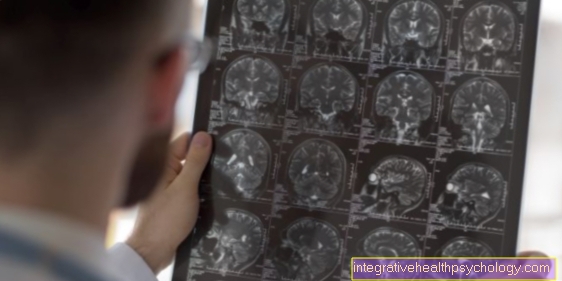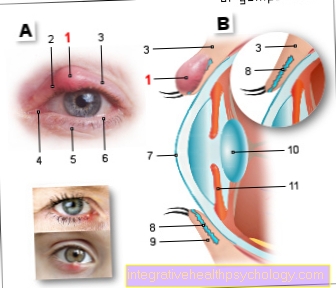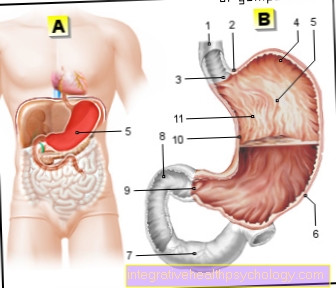Renander's disease
Synonyms
Bone necrosis of the sesame bone
introduction
Renander's disease is a disease that results in death (necrosis) of the bone or parts of a bone. Renander's disease specifically describes the death of the sesamoid bone of the big toe. It is based on what is known as a bone infarction, which leads to an insufficient supply of the bone material with nutrients from the blood and oxygen. The poorly supplied bone tissue is eventually broken down. This process is also known as avascular necrosis, as there is no blood supply in these areas.

causes
On the one hand, bone necrosis is classified according to the affected joint or bone, and on the other hand, it can also be classified according to the cause. When a bone or part of a bone dies, there are various possible causes.
In the case of Renander's disease, bone necrosis can occur previous injuries or overload arise. In this case one speaks of one post-traumatic bone necrosis. As a result of an injury and constant incorrect loading of the foot, the sesamoid bone of the big toe develops minimal cracks, so-called Microtraumas. These can be permanent. Next Pain at this point it is possible that there will be a Obstruction of the blood supply of the bone comes. This ultimately leads to the death of the following bone material. The bone is increasingly broken down.
Another possible cause is an existing inflammation. A wound can carry germs and a infection trigger. They eventually settle on the bone and multiply increasingly. An inflammatory reaction occurs on the bones and surrounding soft tissue structures, which can also hinder the blood supply to the sesamoid bone. This can lead to necrosis if the undersupply condition persists for too long. If there is infection-related necrosis, this is called septic bone necrosis designated.
Furthermore, there are rare cases in which no clear cause can be found. Neither infection nor injury contributed to the undersupply of the bone. In this case it will aseptic bone necrosis called. Diseases like that Sickle cell disease, which has an inherited change in red blood cells, can lead to aseptic bone necrosis. Also the Systemic lupus erythematosus (SLE), a rare one Autoimmune diseasewhich causes damage to the skin and various organs, is one of the triggers of this special form of bone necrosis.
Other factors can also lead to a deteriorated blood supply. These include diving, working in compressed air, such as in tunnels or mining, chemotherapy, radiation, and various drugs such as Cortisone.
Appointment with ?

I would be happy to advise you!
Who am I?
My name is dr. Nicolas Gumpert. I am a specialist in orthopedics and the founder of .
Various television programs and print media report regularly about my work. On HR television you can see me every 6 weeks live on "Hallo Hessen".
But now enough is indicated ;-)
In order to be able to treat successfully in orthopedics, a thorough examination, diagnosis and a medical history are required.
In our very economic world in particular, there is too little time to thoroughly grasp the complex diseases of orthopedics and thus initiate targeted treatment.
I don't want to join the ranks of "quick knife pullers".
The aim of any treatment is treatment without surgery.
Which therapy achieves the best results in the long term can only be determined after looking at all of the information (Examination, X-ray, ultrasound, MRI, etc.) be assessed.
You will find me:
- Lumedis - orthopedic surgeons
Kaiserstrasse 14
60311 Frankfurt am Main
You can make an appointment here.
Unfortunately, it is currently only possible to make an appointment with private health insurers. I hope for your understanding!
For more information about myself, see Lumedis - Orthopedists.
Symptoms
The classification of bone necrosis is based on the one hand on the affected joint or bone, on the other hand according to the cause.
therapy
The treatment of bone necrosis of the sesamoid depends on the Severity and extent of the damaged bone material. In addition, there are different forms of bone necrosis, which also have to be treated differently. in the Initial stage there is still the possibility of recovery of the bone. A adequate protection of the foot against stress from crutches is helpful here.
At the same time, a hyperbaric oxygen therapy The oxygen content of the blood can be increased in order to improve the supply of damaged tissue. The patient breathes in pure oxygen at an increased pressure for a certain period of time, which means that more oxygen is absorbed. Drug therapy is also often used. Pain medication how Paracetamol or Ibuprofen and anti-inflammatory drugs how Glucorticoids come into question. These are often medicines that contain cortisone.
If the necrosis is very advanced and the nearest joint threatens to be affected, an operation is recommended. In this the dead bone material is removed and possibly through Bone grafts replaced. In the case of the sesamoid bone, removal of the bone is a neat way to completely remove the necrosis and a Prevent spread.
cure
In the case of Renander's disease mostly exist very good chances of recoverybecause the sesamoid is an extremely small area of necrosis. In addition, removing the sesamoid bone is a comparatively small operation. This often avoids the risk of spreading or inflammation. Spontaneous healing without surgery is also possible.
However, if larger bones or bone parts are affected by the necrosis, the therapy turns out to be correspondingly more complex and difficult.





























